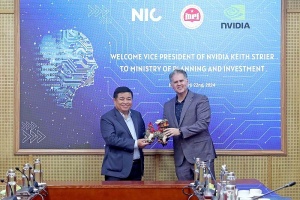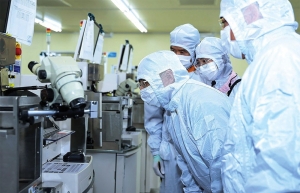Call to arms for semiconductor roles
At the seminar on semiconductor chip design on April 13 in Hanoi, Harsh Bharwani, CEO of Jetking Group, said that the current value of the global chip industry was $500 billion, and this was expected to increase four-fold in the coming years, which will lead to a huge demand for jobs to meet industrial development.
He believes that training students in Vietnam for this billion-dollar industry will bring great potential over the next 10 years.
“Vietnam has many strengths in chip design with a young population who have a good understanding of how to use technology,” Bharwani said.
| Vietnam will need tens of thousands of semiconductor engineers within a short time span, Photo:Shutterstock |
One of the most attractive factors in becoming a semiconductor chip design engineer is the salary. Nguyen Thanh Yen, CEO of CoAsia SEMI Vietnam, said new graduates usually have a starting salary of about $10,000 per year, not including bonuses.
“It can be up to $15,000 for those with one to three years of experience, up to $25,000 for those with 4-6 years of experience, and as much as $80,000 or even higher with more experience,” Yen said.
The salaries of those in semiconductor and integrated circuit (IC) design are largely not based on university certificates.
Le Hai Anh, director of the Dolphin Technology Vietnam Centre, said that skills and performance are more important than qualifications in the industry.
“The difference of income is not based on qualifications but on skills, self-study, and the most importantly, the ability to solve problems,” Anh said. “At present, there is a shortage of human resources in the chip industry worldwide. Well-trained human resources in Vietnam can keep investors here. The more high-quality human resources Vietnam has, the stronger the anchor is, to lure investment to flow into the country.”
The salary of semiconductor chip design engineers in Vietnam is higher than other industries but lower than in developed countries like the US. Yen said that with low labour costs for semiconductor chip design engineers and other advantages, many businesses around the world will recruit personnel from Vietnam.
“The industry has great potential but also asks employees to be passionate, persistent, and patient. It takes engineers about 10 years to enjoy their results,” Yen said.
Semiconductor destination
Hoang Nam Tien, vice chairman of FPT University, has emphasised patience and self-discipline to achieve success.
“In the next five years, Vietnam will be the must-come destination of the world’s semiconductor industry. We are confident of training students to start working in the semiconductor chip design in just over a year or so,” he said.
Tien said that the current semiconductor industry was undergoing a development process similar to the software industry in the past.
FPT Group set the goal of exporting software nine years ago, and people said it was delusional. However, through huge efforts, in 2023 FPT earned $1 billion from software exports and added its name to the list of the biggest software businesses in the world.
“Based on that case and the increasingly solid foundations for developing the semiconductor industry, I believe that Vietnam can participate more deeply in the global semiconductor industry’s supply chain,” Tien said.
Vietnam has great opportunities in the semiconductor industry, especially after the visit of US President Joe Biden last September that upgraded ties with Vietnam to a comprehensive strategic partnership. This also opens up opportunities for cooperation with markets such as Japan, South Korea, and Taiwan for Vietnam to develop its semiconductor industry.
“I believe that these new opportunities are good for Vietnam and young people. They will enable Vietnam’s semiconductor to become the key industry in the future, and enable the country to escape the middle-income trap,” said Vo Xuan Hoai, deputy director general of the National Innovation Centre (NIC).
Many large corporations and businesses in the electronics and semiconductor industry have set foot and planned to expand investment in Vietnam such as Intel, Samsung, Synopsys, Qualcomm, Infineon, and Amkor.
The Ministry of Planning and Investment has also been building a human resource development strategy for the semiconductor industry by 2030, with the goal of training 50,000 engineers. Yen from CoAsia SEMI said it was a good sign that the government showed such strong interest in the industry.
“One or two years ago, only Hanoi University of Science and Technology offered in-depth training in semiconductors and electronic design. Currently, there are many universities and training centres interested in this industry,” Yen said.
Investing in human resources
Besides its many opportunities, the semiconductor industry also faces big hurdles. In particular, attracting foreign investors to the industry requires huge investment. For example, in India, for an investment of $20 billion, the government may spend about $10 billion.
Tien from FPT University said that building chip and semiconductor laboratories was also a difficulty for Vietnam.
“Setting up and maintaining these laboratories is a huge cost of up $300 million, according to Taiwan’s experience,” he said. “Therefore, it is difficult for organisations, universities, and businesses to gain and spend such a large amount in a chip lab.”
The human resource development scheme for the semiconductor industry by 2030 targets establishing four national shared semiconductor centres: two in Hanoi, one in the central city of Danang, and one in Ho Chi Minh City. In addition, there will be about 18-20 basic training centres located in universities. And the US will sponsor and invest in two laboratories specialising in measurement and testing.
Experts believed that universities and colleges may not be able to meet demand, and be too late.
“A possible solution is to promote vocational training programmes, short-term courses or business-linked training in the semiconductor industry. This will contribute to quickly providing skilled human resources to the labour market and meet the growing needs of the industry,” said Hoai of the NIC.
Bharwani from Jetking emphasises the foreign language that Vietnamese students will need to improve significantly, in addition to improving practical skills, and enhancing their overview of the global market, such as getting updated on new trends in chip design, and AI.
“When learning any technology, you need to do well in both theory and practice,” Bharwani said.
Any country in the world that wants to participate in the supply chain of the semiconductor industry must have a very long preparation, 10-20 years, or even 30-50 years. Developing and training human resources that are good in quality but also effective and fast at developing is critical, he added.
 | MPI meets with Nvidia vice president to discuss AI and semiconductor cooperation Minister of Planning and Investment Nguyen Chi Dung met with vice president of US tech firm Nvidia Keith Strier on April 22 to discuss Vietnam's semiconductor and AI ecosystem. |
 | Localities on first step towards training microchip labour force A number of localities are coordinating with manufacturers to train workers for the semiconductor industry, mostly in the basic stages of assembly and testing. |
| A strengthened high-tech workforce for semiconductors Vietnam has plenty of work to do if it wants to become a true global hub for semiconductor manufacturing. Dr. Quan Le, principal investigator for the Semiconductor Workforce Development Research Grant under Fulbright University Vietnam, covered the potential for Vietnam and how to reach it with VIR’s Vy Vy. |
What the stars mean:
★ Poor ★ ★ Promising ★★★ Good ★★★★ Very good ★★★★★ Exceptional
Related Contents
Latest News
More News
- Businesses ramp up production as year-end orders surge (December 30, 2025 | 10:05)
- Vietjet chairwoman awarded Labour Hero title (December 29, 2025 | 13:06)
- How to unlock ESG value through green innovation (December 29, 2025 | 10:03)
- AI reshapes media and advertising industry (December 29, 2025 | 08:33)
- FPT and GELEX sign deal to develop blockchain tech for global markets (December 29, 2025 | 08:29)
- Vietnam’s GDP forecast to grow by 9 per cent in 2026 (December 29, 2025 | 08:29)
- Women entrepreneurs are key to Vietnam’s economic growth (December 29, 2025 | 08:00)
- Vietnam's top 500 value-creating enterprises announced (December 27, 2025 | 08:00)
- The PAN Group shaping a better future with ESG strategy (December 26, 2025 | 09:00)
- Masan Consumer officially lists on HSX, marking the next phase of value creation (December 25, 2025 | 13:20)

 Tag:
Tag:




















 Mobile Version
Mobile Version